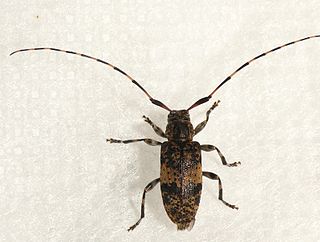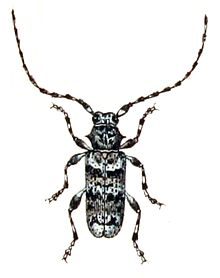
Lamiinae, commonly called flat-faced longhorns, are a subfamily of the longhorn beetle family (Cerambycidae). The subfamily includes over 750 genera, rivaled in diversity within the family only by the subfamily Cerambycinae.

Linnei is a railway station on the Taiwan Railways Administration West Coast line located in Linnei Township, Yunlin County, Taiwan.

Linnei Township is a rural township in Yunlin County, Taiwan. It is the second smallest township in Yunlin County after Baozhong Township.
Acanthocinini is a tribe of longhorn beetles of the subfamily Lamiinae. It was described by Blanchard in 1845.
Pseudastylopsis is a genus of longhorn beetles of the subfamily Lamiinae. It was described by Dillon in 1956.

Leiopus femoratus is a species of longhorn beetles of the subfamily Lamiinae. It was described by Fairmaire in 1859, and is known from Bulgaria, the Caucasus, France, northern Iran, southern Russia, and Turkey. The beetles inhabit a variety of deciduous trees, including those in the genera Castanea, Carpinus, Juglans, Ficus, and Tilia. They measure 5-8 millimetres in length, and can live for approximately 1–2 years.
Leiopus kharazii is a species of longhorn beetles of the subfamily Lamiinae. It was described by Holzschuh in 1974, and is known from Azerbaijan and northern Iran. The beetles inhabit deciduous trees. They measure 6-10 millimetres in length, and can live for approximately 1–2 years.

Leiopus nebulosus is a species of longhorn beetle of the subfamily Lamiinae. It was described by Carl Linnaeus in his landmark 1758 10th edition of Systema Naturae. It contains two subspecies; the first, L. nebulosus nebulosus, is known from Europe and Russia, and the second, L. nebulosus caucasicus, is endemic to the mountains of the Caucasus. The beetles inhabit deciduous trees, including those in the genera Fagus, Quercus, Carpinus, Juglans, Acer, Ulmus, Betula, Salix, and Prunus. They measure 5–10 millimetres in length, and can live for approximately 1–2 years.

Leiopus punctulatus is a species of longhorn beetles of the subfamily Lamiinae. It was described by Paykull in 1800, and is known from Europe. The beetles measure 6-8 millimetres in length, and can live for approximately 1–2 years. They inhabit poplar trees, especially the white poplar, but also Populus tremula and Populus nigra. The species is endangered in Central Europe due to a decrease in the white poplar population.
Leiopus syriacus is a species of longhorn beetles of the subfamily Lamiinae. It was described by Ludwig Ganglbauer in 1884, and is known from Syria, Turkey, and Lebanon. The beetles inhabit deciduous trees, including the walnut species Juglans regia. They measure 6-8 millimetres in length, and can live for approximately 2 years.
Hylettus nebulosus is a species of longhorn beetles of the subfamily Lamiinae. It was described by Monné in 1982, and is known from southeastern Brazil.

Lethrinus nebulosus, the spangled emperor, green snapper, morwong, north-west snapper, sand bream, sand snapper, sixteen-pounder, sharie, sheri and yellow sweetlip, is a species of marine ray-finned fish belonging to the family Lethrinidae, the emperors and emperor breams. This species is found the Indo-West Pacific region.

Leiopus linnei is a species of beetle in the family Cerambycidae.

Eunidiini is a tribe of longhorn beetles of the subfamily Lamiinae. It was described by Téocchi et al. in 2010.

Homonoeini is a tribe of longhorn beetles of the subfamily Lamiinae. It was described by James Thomson in 1864.

Crossotus is a genus of longhorn beetles of the subfamily Lamiinae.

Mulciber is a genus of longhorn beetles of the subfamily Lamiinae, containing the following species:

Potemnemus is a genus of longhorn beetles of the subfamily Lamiinae, containing the following species:
Xenohammus is a genus of longhorn beetles of the subfamily Lamiinae, containing the following species:

Neotibicen linnei, commonly called Linne's cicada, is a species of large bodied annual cicada in the genus Neotibicen. It is native to the Eastern United States and Canada. N. linnei in Oklahoma is most easily identified by the coastal margin bent at the end of the radial cell and opercula truncated obliquely at the extremities.














